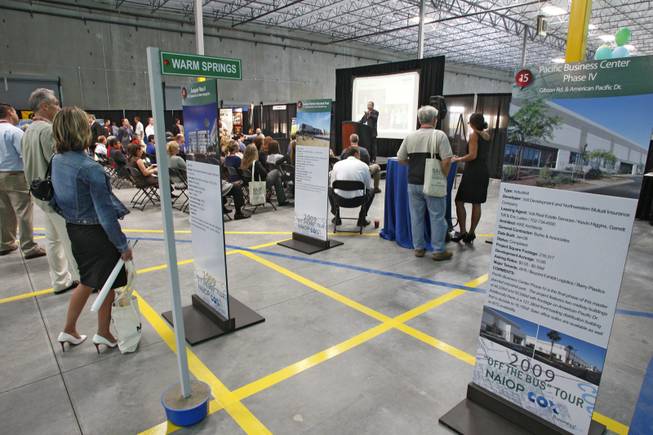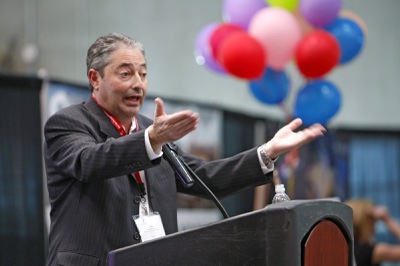
At a NAIOP seminar, attendees listen to John Restrepo, center, of the Restrepo Consulting Group.
Friday, Oct. 9, 2009 | 3 a.m.
Sun Topics
Sun Coverage
The bad news is easy to see: Commercial vacancy rates continue to rise, rents keep dwindling and the potential exists for a large number of foreclosures to hit the market.
Despite those clouds over commercial real estate, some in the industry are hoping that the market may be close to its bottom. Some sense there may be reason for optimism in that they know what they are facing even if it’s a new meaning of what’s normal.
That was some of the sentiment expressed last week in the annual showcase of the commercial real estate industry. About 300 industry members attended the display of office and industrial properties sponsored by the Southern Nevada chapter of NAIOP, the commercial real estate development association.
“I think people are feeling better now than at the beginning of the year,” said Brad Schnepf, the president of Marnell Properties. “At the beginning of the year, there was a lot of uncertainty going on. I see people are now understanding the reality of it and adjusting their business models accordingly and working towards a different way of thinking and anticipating what the upturn might look like and when.”
The numbers show a continuation of the slide that has been under way for several quarters and people are concerned about where the market is going, said John Restrepo, former NAIOP president and principal of Restrepo Consulting Group.
“They know Las Vegas is going to come out of this at some point, but the question is when,” Restrepo said. “Everyone is being challenged right now. Business is down and the economy is still shedding jobs. It is kind of hard to be positive when you shed 60,000 jobs in one year.”
Colliers International reported the vacancy rate for industrial space rose from 12.4 percent in the second quarter to 13.3 percent in the third quarter. In retail, CB Richard Ellis reported the vacancy rate rose to 13.1 percent in the third quarter, up from 12.6 percent.
Both Colliers and CB Richard Ellis report an office vacancy rate of 22 percent in the third quarter, up from 21.8 percent and 21.1 percent, respectively, during the second quarter.
“We are starting to stabilize, and I don’t expect the vacancy for office, industrial and retail is going to get a lot higher,” said Colliers Research Manager Matt Stater.
Restrepo is a little more pessimistic in his predictions. He said he expects his third quarter numbers to come in at a 22 percent vacancy for office, 9.7 percent for retail and 13 percent for industrial.
But by the end of the year, Restrepo said he expects office vacancy to range between 23 and 25 percent, industrial vacancy between 13 to 15 percent and retail vacancy between 10 and 11 percent.
“We are going to stabilize at higher vacancy rates than we have seen in the past,” Restrepo said. “We are declining at a slower rate, but it does not mean we are hitting bottom. It is all driven by job growth and consumer spending.”
Dave Dworkin, research director with Grubb & Ellis, said his firm’s third quarter numbers will be similar to the second quarter’s. The change is between submarkets because companies are relocating to take advantage of deals, he said.
By the end of the year, vacancy rates should continue to increase but Dworkin said the worst may be behind the market, and he senses people are more confident than they were a year ago. Part of the reason is the opening of CityCenter, which many see as a “beacon of hope” in that it is being completed while other projects didn’t make it. That should help confidence return to the market from out-of-town investors, he said.
“People are still holding on the best they can,” Dworkin said of landlords and tenants. “I think we have probably hit bottom. I think those that have hung in there can hold on longer. There are still deals happening. I think people are more optimistic about 2010.”
Schnepf describes his mood as “cautiously optimistic’’ even though the economy remains slow and there has been no improvement in the unemployment rate — the indicator everyone in commercial real estate is watching as a gauge for demand. The jobless rate in Las Vegas in August rose to 13.4 percent.
It helps slow a rise in vacancy rates that some projects have stalled and that there are few new construction projects, Schnepf said. In addition, the worst might be behind in terms of companies shuttering operations and vacating space, he said.
“My expectation is that 2010 will be a lot like it is now,” Schnepf said. “There is a lot of inventory in town. There is a lot of activity on the leasing side, but we are still going to stay on this path of slow absorption.”
The biggest unknown on commercial real estate is whether the market will get inundated with a large number of foreclosures. Observers said some lenders have been working with property owners on extending loans, but more and more properties could eventually be repossessed.
Nevada State Bank reported it is aggressively marketing foreclosed commercial properties and is attempting to sell many of them in the fourth quarter and into the first quarter of 2010.
“The X factor is foreclosures and is that going to derail things or slow things down. I think it is going to slow things down,” Stater said. “The foreclosure tsunami looks like it’s hitting now, but a lot of the indications are it is going to get worse next year. We are not sure how this is going to pan out, but if vacancy rates stay high and asking rents keep dipping, that is going to push more and more properties into foreclosure.”
But the foreclosures will be part of any rebound, Restrepo said. When those foreclosure sales start, that should help stabilize prices and ultimately spur the recovery like has started happening in the housing market, Restrepo said.
“We are getting a lot more investor groups coming to us now looking for an economic overview of the market,” Restrepo said. “That tells me investors have a positive view of Las Vegas for the long term and are coming in now to pick up deals.”



Join the Discussion:
Check this out for a full explanation of our conversion to the LiveFyre commenting system and instructions on how to sign up for an account.
Full comments policy